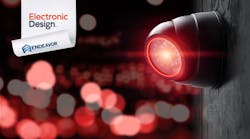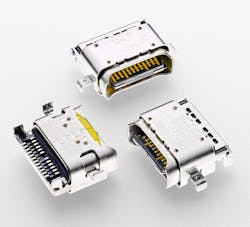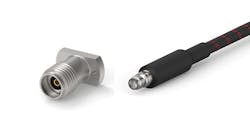This article appeared in Electronic Design and has been published here with permission.
What you'll learn:
- What are the main drivers of the rising outdoor surveillance market?
- Challenges and solutions in smart surveillance design.
- What are the best connectors to use in designing smart-city surveillance systems?
A smart city ecosystem effectively integrates physical, digital, and human systems to help drive a sustainable, prosperous, and inclusive future for all who live and work there. A networked infrastructure commonly serves as a foundation to improve economic and political efficiency and helps enable social, cultural, and urban development, as well as help foster social and environmental sustainability.
Technology designers and manufacturers commonly have key roles in helping to create long-term growth in this ecosystem. Increases in government initiatives, urban population numbers, and demand for public safety seem to be driving this growing trend. And even though the COVID-19 pandemic seems to be pushing some people at least temporarily away from cities, the pandemic is also helping accelerate smart-city trends.
As smart cities evolve, surveillance can play a powerful role in improving quality of life and the safety of our societies. Technologies such as real-time video surveillance, facial recognition, and license-plate reading are becoming widely used to help ensure public safety. In this article, we will explore some of the demands and trends in smart surveillance technology within the smart city ecosystem and review what many engineers may need to consider when designing smart surveillance products and components.
Market Drivers
5G: As 5G rollouts grow globally and in emerging markets, offering faster data transmission and the ability to connect significantly more devices at once, more cities will probably dive deeper into the smart city trend. 5G capabilities can make smarter technology more accessible and open new market opportunities for Internet of Things (IoT) solutions, such as in outdoor surveillance, physical security, government, and transportation/traffic control.
Public safety: Crime normally plays a large role in quality of living, real-estate value, and more in urban areas, and citizens seem to be getting more comfortable with the idea of surveillance playing a role in crime prevention.
Aging infrastructure: In 2017, the U.S. received a D+ on its infrastructure report card from the American Society of Civil Engineers. That meant deteriorating roads and bridges across most U.S. cities were not only dangerous, but likely “impeding our ability to compete” in the global economy and spurring job and GDP losses by the millions and trillions, respectively.
At CES 2020, a panel of experts discussed how infusing new technology into these crumbling infrastructures can offer renewable solutions. Smart city technology, as well as and often in conjunction with other existing digital technology, can reduce infrastructure project costs in some regions by as much as 45%. Smart streetlights, connected cars, automated traffic programs, surveillance programs, etc., can help create communities that are resilient and sustainable through the creation of the right public-private partnerships to defuse some of the costs.
Sustainability: Sustainability is a long-term trend that should also be considered in that holistic view. Urbanized areas account for a major portion of global energy consumption, releasing up to an estimated 80% of greenhouse gases (GHG). Smart city solutions can reduce GHG emissions by at least 10% to 15%.
Cybersecurity and privacy: While many people are becoming more comfortable with smart city technology and surveillance in their cities, privacy issues remain and should be considered along with cybersecurity as trends to be aware of when designing for the smart city market.
Keys to Efficient Designs
Outdoor smart surveillance tools, devices, and systems can present several challenges for design engineers. The following includes important considerations for designing certain outdoor smart surveillance devices.
Durability: Most outdoor surveillance devices may need to be durable enough to withstand harsh weather, temperatures, and ultraviolet (UV) light, as well as, in some cases, wildlife contact and vandals. Ruggedized components and sealed connectors should be used where possible in devices that are commonly exposed to these harsh elements.
- Flat flexible cable (FFC) connectors are just one example of a versatile interconnection solution that can enable flexibility and durability in high-performance applications.
- Rugged USB Type-C connectors with IPX8 waterproof ratings are a useful choice for outdoor surveillance devices. These connectors can support a variety of different protocols and transfer data at speeds up to 10 Gb/s, and can be useful with outdoor USB Type-C cables for maximum robustness and performance in rugged environments.
Data rates and bandwidth: Consider the current and potential future bandwidth needs for each device or system, as it may vary depending on the purpose and the network it will be sending data on. For example, traffic-control devices may require more bandwidth than parking control to accommodate the data and speeds often needed for the functionality.
Anything with video or facial recognition normally needs even higher bandwidth capabilities to capture and deliver clear images. As more data throughput is required, better antennas may be needed—consider multiple antennas or MIMO antennas to optimize data speed. USB Type-C connectors and high-speed board-to-board connectors can offer reliable signal integrity and excellent signal speed, transferring data at up to 10-Gb/s data speeds and beyond.
Miniaturization: Outdoor surveillance devices often need to be small so as not to stand out in their environment. In addition, the need may arise for quite a bit of functionality to be designed into that small space, so miniaturized components can be key. Some design considerations may include small centerline or pitch spacing, lower profile heights, and lighter interconnect solutions.
Many of these components, of course, normally must also be ruggedized and/or sealed to function optimally in extreme weather, temperatures, and humidity. Many miniaturized components are designed for tight spaces, high data speeds, and harsh environments, including:
- SMA/SSMA and micro coax cables and connectors
- AMP CT, AMP Mini CT, and AMP Micro CT interconnects
- FPC connectors
- 0.5-, 0.6-, .8-, and 1-mm free height connectors
- Mobile battery connectors
- USB Type-C connectors
Signal integrity: Especially in most smart surveillance devices used for crime detection and prevention, throughput and signal integrity are often critical factors. Poor throughput can reduce bandwidth and compromises data and video output, potentially creating blurry images in video or facial recognition.
Spring fingers help prevent EMI noise and static, can provide a highly reliable connection and a cost-effective solution for antenna feeds, as well as allow versatility in design because of the limited space they occupy. Board-level shielding can be used to isolate board-level components, which could help reduce EMI susceptibility and minimize crosstalk without impacting system speed. One- and two-piece board-level shields can be useful for thinner devices with multiple antennas, higher data rates, and increased operating frequencies.
Wireless connectivity: Wireless connectivity outdoors has often presented certain challenges with multiple sources of potential interference and signal blocking. Tall buildings, landmarks, and weather, for example, can all influence connectivity and integrity of the network. As engineers across industries design in more wireless communications technologies for advanced functionality, the complexity of the communications environment and the likelihood of radio interference normally increases.
With its speed, reliability, and device density connection capability, 5G technology can be the cornerstone of the smart device ecosystem since it can provide interoperability and capability for end-to-end solutions like never before. Preventing interference from outdoor elements and other device components may be key, which also means the choice of antenna often is critical to a device’s reliability and function.
Modularity: Today’s engineering designs typically require high performance, signal integrity, electromagnetic compatibility (EMC) compliance, and high-speed data transfer with power and signal connections. Connectors commonly have smaller profiles to use less space, are lighter in weight, and often have to withstand varying environmental conditions. The right interconnects can help design engineers adapt and be flexible to continually push the boundaries of design, allowing engineers to address tough design specs without compromising on connection reliability.
Low-profile flexible-printed-circuit (FPC) connectors can give designers flexibility and space-saving capability to include more technology into smaller spaces. Lightweight FPC connectors can be useful where small centerline spacing makes larger wire-to-board interconnects impractical. In addition, many applications require connectors that provide reliability, such as latching features, along with gold plating for more precision and accuracy.
As smart city deployments grow and outdoor surveillance applications grow with them, design engineers will be challenged to create devices that meet the efficiency and performance requirements outlined above. Fortunately, the marketplace offers many choices in components for successful designs.


